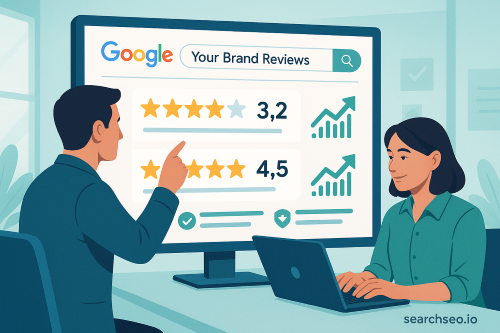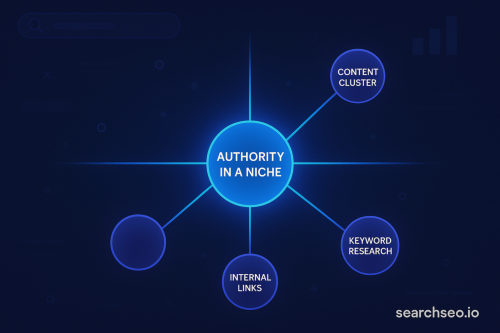AdSense safe traffic is any visit that complies with Google’s click-quality standards and boosts your revenue instead of risking a ban. For publishers, the distinction between “safe” and “invalid” is the difference between a growing paycheck and a sudden account suspension. This evergreen guide deconstructs the latest policy landscape, shows exactly how to buy AdSense-compliant traffic in 2025, and demonstrates how SearchSEO.io’s CTR bot can lift real-user signals without breaking the rules.
Understanding AdSense safe vs invalid traffic
Google’s invalid-traffic algorithms explained
Google runs multi-layered machine-learning models that score every click and impression in real time. The system checks IP reputation, click patterns, rapid page refreshes, and mismatched user agents to flag suspicious activity. A high-risk pattern automatically routes your account to manual review.
Real-user signals Google looks for
Before you invest a dollar, know the benchmarks Google trusts:
- Click-through rate (CTR) that aligns with the page topic and ad layout
- Session duration that proves visitors are reading instead of pogo-sticking
- Invalid-traffic (IVT) rate under 1–2 % in most verticals
- Natural scroll depth and event timing (mouse movement, touch events)

Why bots and exchanges trigger bans
Mass-volume bot traffic and one-click exchanges rarely replicate human dwell times or diversified referrers. When Google sees mirrored click timestamps or a spike in a single /?gclid= parameter, it retroactively claws back earnings and may suspend your entire account.
Why safe traffic matters for publishers
June 2025 brought a fresh wave of policy tweaks. Google deprecated the “Additional ad-technology vendors” opt-out control, signaling fewer manual work-arounds and stricter automation across the network.
Here is what that means for your bottom line:
- Clawbacks hurt more than CPC drops. A clawback forces you to return last month’s payout plus chargebacks on the current month.
- Suspension windows are longer. Recent enforcement emails cite 30-day site suspensions instead of the old 7-day warning.
- Automation demands cleaner data. The loss of opt-out toggles means Google decides which bidders see your slots, so IVT spikes reduce demand and cascade into lower CPMs.
Revenue math reality check
A $0.50 CPC at 1 % CTR generates $5 RPM. If IVT rises to 15 %, Google can void $0.75 per 1 000 impressions, wiping out most of your margin.
Traffic-quality metrics you must track
Publishers who survive policy audits obsess over metrics beyond pageviews. Below are the key signals and how to benchmark them inside GA4 and native AdSense reports.
- IVT %: Keep it < 2 %. In GA4, build an exploration report that isolates proxy IP addresses and datacenter ASNs.
- Session duration: Aim for 60–90 seconds minimum on content pages.
- Pages per session: 1.6+ indicates genuine interest.
- Bounce rate: Sub-40 % for evergreen posts; news can sit higher.
Set up a GA4 audience trigger to fire an email alert if IVT exceeds your threshold for three consecutive hours. That early warning lets you pause any campaigns before Google flags them.
Legit ways to acquire AdSense-compliant traffic
Below is a practical tour of safe acquisition channels. First, a brief overview, then the actionable bullet points.
Earned sources: SEO content hubs and topical clustering
Strategic clusters target search intent depth, sending “buy website traffic AdSense safe” readers into pillar pages that interlink with supportive answers.
Action checklist
- Map out topical hubs with a keyword graph.
- Publish long-form posts that answer every sub-query.
- Link out to credible studies to raise E-E-A-T signals.
Paid sources: native ads, discovery ads, buying traffic for AdSense (with filters)
Native networks like Taboola and Outbrain let you set IVT caps and site whitelists. When you buy traffic, require the vendor to expose raw logs so you can reconcile clicks.
Programmatic and social ads – placement whitelists
Use managed placements in Google Ads’ Display network and specify only high-reputation domains. On social, split campaigns by platform and exclude in-app browsers that inflate bounce rate.
Evaluating “AdSense safe traffic” services and bots
Not all vendors are equal. Here is a two-sentence primer before diving into the vetting bullets.
Vetting checklist
- Transparent referrers in the log files
- Refund policy tied to IVT audits
- < 2 % guaranteed IVT rate
- Public Terms of Service that forbid forced clicks
Buy-offer summaries vs SearchSEO.io CTR bot
- Marketplace bundles: Low CPM but limited targeting, often mixed referrers.
- Cheap web-exchanges: Masked iframes, zero refund protection.
- SearchSEO.io CTR bot: Adjustable dwell time, real browser fingerprints, integrates GA4 for anomaly alerts.
Red-flag signs
- Pop-unders that hijack the _blank target window
- Iframe ad stuffing
- Referral strings with adf.ly style shorteners
Step-by-step guide: buying Google-AdSense safe traffic
This section walks you through the safest workflow. Read the primer, then follow each step.
- Set clear KPIs
- CTR uplift goal (for example, 1 % to 1.4 %)
- Target RPM increase (say, +20 %)
- CTR uplift goal (for example, 1 % to 1.4 %)
- Choose geo wisely: US traffic commands 2–3× higher CPC than many regions thanks to advertiser demand.
- Run a small-budget test: Allocate 10 % of daily earnings or a $50 floor, whichever is higher.
- Monitor IVT daily: Pull AdSense AdMob IVT widget or use “adsense safe traffic software” with webhook alerts.
- Scale after seven days: If IVT stays under 2 % for a full compliance window, double the spend.
Slot keywords naturally: trusted “adsense safe traffic service” providers typically let you “adsense safe traffic buy” packages in LTE tiers. Always read the fine print.
Common pitfalls & how to stay policy-compliant
Before bullet points, remember that short-term “hacks” often kill long-term earnings.
- Traffic-exchange myths: An “adsense safe traffic exchange” usually shares visitors among low-quality sites, inflating IVT.
- Free-traffic traps: “Free adsense safe traffic” offers farm your site for pop-ups.
- Domain parking risks: Expired domains with residual bot traffic can tank your average. Always sandbox new domains and request review from your account rep.
Advanced optimization tips
Once you have a clean baseline, move to optimization features that compound revenue without risking policy strikes.
- A/B ad layout tests: Serve Control vs Variant only to safe-traffic cohorts so the test does not skew CTR network-wide.
- Real-time fraud alerts: Pair “adsense safe traffic software” with Cloudflare logs for quick IP blocking.
- Rules-based bidding: Automate social ad budgets so high-income geos receive priority whenever CPC goes below your target.
Bonus topic: Geo-pricing dynamics. A US click may pay $0.50 while the same keyword fetches $0.18 in India. Allocate budget where EPC is highest.
Final thoughts & next steps
Google’s policies tighten every year, yet opportunity grows for publishers who master traffic quality. By prioritising AdSense safe traffic, monitoring IVT daily, and scaling only proven sources, you protect revenue and advertiser trust.
Ready to scale traffic safely?
Start your 7-day free trial of SearchSEO.io’s AdSense-safe CTR bot today and watch legitimate revenue rise. The tool automates compliant engagement signals, gives real-time IVT alerts, and lets you pause with one click—100 % risk-free.


.svg)

.svg)
%201.png)








.svg)